Explore Cu Chi - South Vietnam Travel, Asia
Cu Chi, a fascinating location that provides a distinctive fusion of historical significance and dynamic local culture, lies tucked away in the heart of Southern Vietnam. Famous for its intricate tunnel system used during the Vietnam War, Cu Chi has transformed into a popular tourist spot, providing visitors with an immersive experience into Vietnam's rich past and present. Cu Chi has enough for everyone, regardless of your interests in history or adventure.
Population: Approximately 400,000 in 2018.
Economy: Home to many industrial zones, Cu Chi’s economy has continued growing through the years, making it one of the most important industrial centers in the outskirts of Ho Chi Minh City.
Landmarks: Famous for Cu Chi Tunnels, Cu Chi Memorial Temple, and Cu Chi Tunnel Museum.
Vietnam
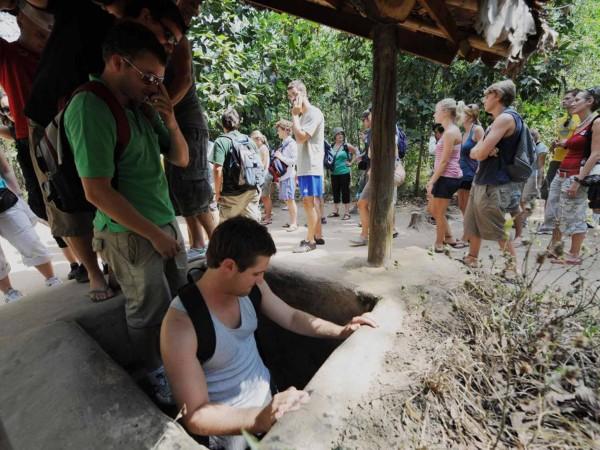
Overview of Cu Chi
History & Culture Influence
Cu Chi's history is deeply intertwined with the Vietnam War, making it a place of great historical importance. The Cu Chi Tunnels, an extensive underground network, played a crucial role in the war, serving as hiding spots, supply routes, and living quarters for Vietnamese soldiers. These tunnels are kept intact as a battle monument today, drawing hordes of tourists eager to witness the Vietnamese people's tenacity and inventiveness. These historical events have shaped this place's traditions, festivals, and daily life, offering tourists a glimpse into the enduring spirit of its inhabitants. Exploring Cu Chi is not just about seeing historical sites; it's about experiencing the local way of life that has evolved through the centuries.
Interaction with The Locals
Cu Chi, a district in Ho Chi Minh City, Vietnam, is home to a population of approximately 400,000 residents. The local community is known for its warm hospitality and strong connection to their rich cultural heritage. Cu Chi’s citizens are predominantly engaged in agriculture and small-scale businesses, reflecting the area's rural charm despite its proximity to the bustling city. The residents take pride in their historical landmarks, such as the Cu Chi Tunnels, and actively participate in preserving their cultural traditions and local customs.

A slice of Cu Chi Tunnel systems - © TienPhong News
Top Attractions in Cu Chi
Cu Chi is brimming with attractions that cater to diverse interests. Each of these attractions highlights a different facet of Cu Chi, from its historical significance and conservation efforts to its picturesque rural landscapes and cultural sites.
- Cu Chi Tunnels: The most significant and well-known attraction in Cu Chi, this extensive underground network, including the Ben Dinh and Ben Duoc sections, offers guided tours where visitors can crawl through narrow passages, see trapdoors, and explore living areas and command centers. These tunnels showcase the ingenuity and resilience of the Vietnamese fighters during the war.
- Cu Chi Wildlife Rescue Station: A visit to the Cu Chi Wildlife Rescue Station provides an opportunity to support wildlife conservation efforts. The station is dedicated to rescuing, rehabilitating, and releasing endangered species. Visitors can learn about the conservation work and observe a variety of rescued animals up close, making it an educational experience for all ages.
- Cu Chi Memorial Temple: The Cu Chi Memorial Temple is a significant cultural site dedicated to the memory of those who sacrificed their lives during the Vietnam War. It features a collection of artifacts, statues, and murals that depict the struggle and resilience of the Vietnamese people. This temple provides a somber yet profound reflection on the past.
- Cu Chi Tunnel Museum: Right next to the Cu Chi Tunnels, the museum provides a thorough examination of the tunnels' past and significance during the Vietnam War. The museum features historical photographs, maps, and detailed exhibits that enhance the understanding of the tunnel system and its impact.
If you are interested in visiting warfare historical attractions, visit Dien Bien, another area with a history rich. Read our article about Dien Bien here.
Must-Try Dishes in Cu Chi
When visiting Cu Chi, savoring the local cuisine is a must. Explore the local dishes as they reflect the rich cultural heritage and agricultural abundance of the region.
- Banh Trang (Vietnamese Rice Paper): In Cu Chi, you can experience freshly made rice paper served with grilled meats, herbs, and vegetables. It’s a light, flavorful dish that showcases local ingredients and traditional preparation methods.
- Banh Xeo (Vietnamese Pancake): Made with rice flour, turmeric, and coconut milk, Banh Xeo is filled with a mix of pork, shrimp, and bean sprouts. It’s crispy on the outside and soft on the inside, typically enjoyed with fresh herbs and a tangy dipping sauce.
- Cu Chi Beef Jerky: A local specialty, Cu Chi Beef Jerky is known for its unique seasoning and preparation. Made from thinly sliced beef that’s marinated and dried, this jerky is a great snack to take home. Its chewy texture and rich flavor mark the distinct taste of the traditional local recipes.
- Goi Cuon (Vietnamese Spring Rolls): Goi Cuon, or fresh spring rolls, are a popular choice for a light, refreshing meal. These rolls are packed with fresh vegetables, herbs, and sometimes shrimp or pork, all wrapped in rice paper. They are often served with a delicious dipping sauce.
- Hu Tieu: This noodle soup is a hearty and flavorful dish, with a rich broth made from pork or seafood. Hu Tieu is typically garnished with fresh herbs, crispy shallots, and a choice of meat, making it a comforting meal for any time of day.
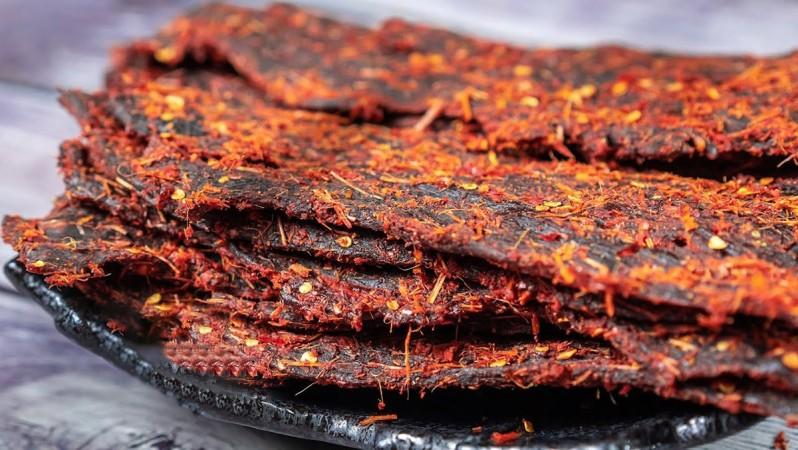
Cu Chi Beef Jerky - © LaoDong
Festivals & Local Celebrations
Cu Chi’s vibrant festivals and local celebrations offer a glimpse into the region’s cultural traditions and community spirit.
- Cu Chi Cultural Festival: This local festival celebrates the unique cultural heritage of Cu Chi with traditional music, dance, and folk performances. It’s a great opportunity to experience the local arts and crafts, as well as enjoy authentic Vietnamese food and community activities.
- Cu Chi Agricultural Festival: This event showcases the agricultural heritage of the region. It typically features exhibitions of local produce, traditional farming techniques, and demonstrations of rural life. Visitors can participate in activities such as rice planting, learn about local crops, and enjoy fresh, farm-to-table meals.
- Quan Thanh Festival: Held annually at the Quan Thanh Temple in Cu Chi, this festival is dedicated to honoring the local deities and spirits. The event includes traditional ceremonies, offerings, and vibrant processions. It provides a unique insight into the spiritual practices and local beliefs of Cu Chi’s residents.
- Vu Lan Festival: This Buddhist festival, celebrated in Cu Chi as well as throughout Vietnam, honors ancestors and deceased family members. It is marked by visits to temples, offerings of food and incense, and ceremonies to express gratitude and respect. The festival is an opportunity for the community to come together in remembrance and reflection.
Discover and participate in Vietnamese festivals with our Vietnam premium tours.
Shopping in Cu Chi
Cu Chi’s shopping options offer a mix of traditional markets and unique local products. Each of these experiences highlights a different aspect of Cu Chi, from its rich street foods to its engaging activities and unique shopping opportunities.
- Cu Chi Market: The local market is a bustling hub where you can find fresh produce, local snacks, and handmade crafts. It’s an ideal spot to experience everyday life in Cu Chi and pick up souvenirs such as traditional textiles and local spices.
- Handicraft Shops: Explore shops that specialize in traditional Vietnamese handicrafts. From intricate pottery and woven baskets to handmade textiles and artwork, these shops offer unique items that reflect Cu Chi’s cultural heritage.
- Local Souvenirs: Don’t miss the chance to buy local souvenirs like Cu Chi beef jerky, rice paper, and traditional Vietnamese cooking utensils. These items make for great gifts and mementos of your visit.
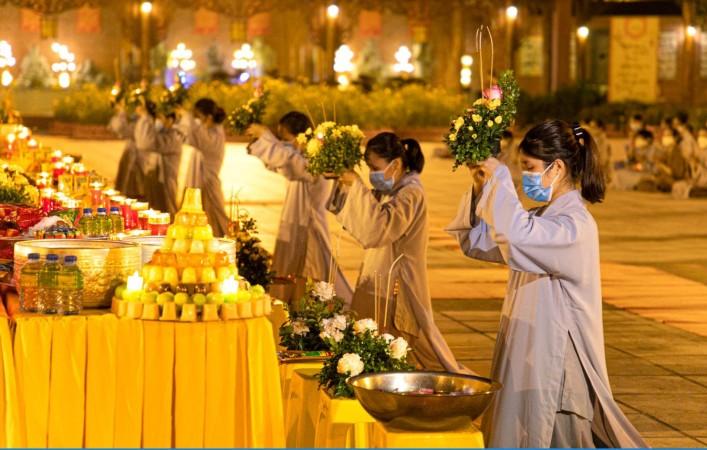
Vu Lan Festival - © Dai Doan Ket
What to Do in Cu Chi
Cu Chi offers a diverse array of activities that cater to a range of interests, from historical exploration to outdoor adventures. These activities offer a comprehensive view of Cu Chi’s historical, cultural, and natural attractions, providing something for every type of traveler.
Cu Chi Tunnel Tours
The best thing to do when visiting the area is to explore the Cu Chi Tunnels. This vast subterranean network was vital in the Vietnam War. Guided tours offer a detailed look at the tunnels, including their construction, usage, and significance. Visitors can crawl through the narrow passages, see various trapdoors, living quarters, and command centers. These tours provide an immersive experience, highlighting the ingenuity and resilience of the Vietnamese fighters. Expect to spend a few hours learning about the tunnels' history and their role in the war effort.
Cu Chi Cycling Tours
For a more relaxed way to experience Cu Chi, consider taking a cycling tour through the scenic countryside. These tours typically cover picturesque rice fields, traditional farms, and small villages. Cycling offers a chance to see the rural beauty of Cu Chi up close and interact with local residents. Many tours include stops at local landmarks, where you can learn about traditional farming practices and enjoy fresh, locally sourced food. It’s a peaceful way to immerse yourself in the area's natural surroundings.
Cultural Workshops
Engage in hands-on cultural workshops to learn traditional Vietnamese crafts. These workshops often focus on skills such as pottery, weaving, or bamboo making. Participating in these activities allows you to connect with local artisans and gain insight into traditional craftsmanship. Workshops are usually led by skilled craftsmen who provide detailed instructions and share their expertise. It’s a great way to create personalized souvenirs and appreciate the artistry of Cu Chi. Learn about many other interesting workshops you can participate in nearby region, Tay Ninh, here.
Weather in Cu Chi: Best Time to Visit
Cu Chi’s tropical climate significantly influences tourism trends throughout the year. Understanding the seasonal weather can help you plan your visit to make the most of your time in the area.
Dry Season in Cu Chi
- Weather: The dry season in Cu Chi is characterized by warm temperatures and low humidity, with daytime temperatures ranging from 25°C to 35°C (77°F to 95°F).
- Outdoor Activities: The dry season is ideal for outdoor activities such as exploring the Cu Chi Tunnels, cycling tours, and boat rides. Thanks to the nice weather and open sky, this time of year is regarded as the busiest travel season.
- Crowds and Costs: Expect higher visitor numbers and elevated prices for accommodation and tours during the peak season. You should book in advance to secure the best rates and availability.
Read more about the activities you can enjoy during the dry season on the local island, Phu Quoc, here.
Wet Season in Cu Chi
- Weather: The wet season brings higher humidity and frequent rain showers, with temperatures averaging between 24°C and 32°C (75°F to 90°F). Rainfall typically occurs in short, intense bursts, often in the afternoon or evening.
- Indoor and Cultural Activities: With occasional heavy rainfall, this season is ideal for indoor activities. Visitors can focus on cultural experiences such as visiting museums, local markets, and participating in cultural workshops.
- Crowds and Costs: The wet season sees fewer tourists, resulting in lower prices for accommodation and tours. It’s a great time to visit if you prefer a quieter experience and want to take advantage of more affordable travel options.
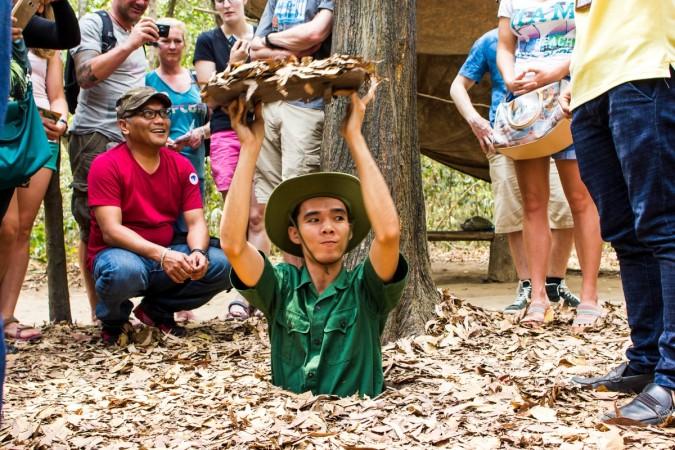
Cu Chi Tunnel Tours - © VOV
Essential Tips for Cu Chi Tunnels Tours
Exploring the Cu Chi Tunnels is a fascinating and educational experience, offering a glimpse into Vietnam's wartime history and the ingenuity of its people. Here are some tips to ensure you make the most of your tunnel tour:
- Wear Comfortable Clothing and Shoes: The tunnels are narrow and can be quite cramped. Wear comfortable, lightweight clothing and sturdy shoes suitable for walking and crawling. Avoid high heels or sandals, as they may not provide adequate support or protection.
- Prepare for Tight Spaces: The tunnels are often very narrow, and some sections may be challenging to navigate. If you’re claustrophobic or have mobility issues, be aware that crawling through the tunnels might not be comfortable. Guides will usually offer alternative viewing options if needed.
- Bring a Flashlight: While the tunnels are illuminated, bringing a small flashlight or headlamp can help you see more clearly in darker sections and enhance your experience. It’s particularly useful for exploring less well-lit areas.
- Stay Hydrated and Bring Water: Cu Chi's climate can be hot and humid, so staying hydrated is important. Bring a bottle of water to keep yourself refreshed during the tour. However, be mindful of the local regulations and guidelines regarding food and drink within the tunnel areas.
- Respect the Site: The Cu Chi Tunnels are a historical site with significant cultural importance. Be respectful by following the guidelines provided by your guide, refraining from touching or disturbing artifacts, and maintaining a quiet demeanor to respect the solemn nature of the site.
- Take It Slow: Exploring the tunnels can be physically demanding. Take your time moving through the narrow passages and be cautious of your surroundings. The experience is meant to be immersive, so don’t rush through it.
- Prepare for Warm Temperatures: Even in shaded areas, the temperature inside the tunnels can be warm. Dress in light, breathable fabrics and consider wearing a hat or cap if you’re sensitive to heat. Applying sunscreen before the tour can also help protect your skin from sun exposure.
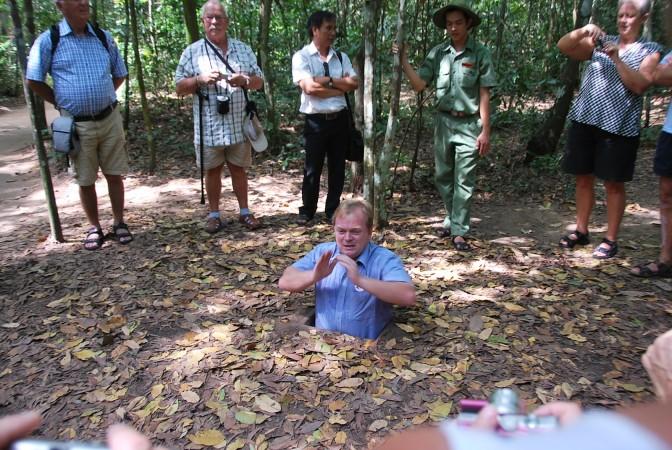
Prepare for tight spaces when joining Cu Chi Tunnels tours - © Vietnam Tourism
Essential Travel Information
Getting Around Cu Chi
Navigating Cu Chi is straightforward with a variety of transportation options available:
- Motorbike Rentals: Motorbikes are a popular and convenient way to explore Cu Chi. Rentals are widely available and offer flexibility for getting around the district. Ensure you have a valid motorcycle license and wear a helmet for safety.
- Taxis and Ride-Hailing Apps: Taxis and ride-hailing apps like Grab are readily available in Cu Chi. These options are comfortable and convenient, especially for travelers who prefer not to drive themselves. Ride-hailing apps often provide fixed fares and reliable service.
- Bicycle Rentals: For a more leisurely way to explore the countryside, consider renting a bicycle. Many local shops offer bicycle rentals, and cycling is a great way to enjoy Cu Chi’s scenic landscapes and visit local attractions at a relaxed pace.
- Public Buses: Public buses connect Cu Chi with Ho Chi Minh City and other surrounding areas. While less flexible than motorbikes or taxis, buses are an affordable option for traveling longer distances. From Cu Chi, you can catch bus to visit tourist popular surrounding areas as well.
ATM & Banking Services
Cu Chi provides a variety of financial and banking services to meet the demands of tourists. ATMs are conveniently located throughout the area, including at major markets, shopping centers, and near popular tourist sites, accepting international credit and debit cards for easy cash withdrawals. Several banks in Cu Chi provide essential services such as currency exchange, cash withdrawals, and general banking transactions.
Where to Stay in Cu Chi
Cu Chi offers a diverse range of accommodation options to suit various preferences and budgets. Visitors can choose from comfortable hotels and guesthouses providing essential amenities and local charm. For those seeking a more immersive experience, there are homestays that offer a closer look at local life and culture. Budget travelers will find affordable hostels and inns with basic facilities, while mid-range options include well-equipped lodgings that balance comfort and value.
Articles for you

Explore Yala National Park - Sri Lanka Travel, Asia
Tucked away in Sri Lanka’s southeastern corner, Yala National Park is where wild nature meets deep tradition. Known worldwide for its leopard population, the park is also home to elephants, sloth bears, crocodiles, and hundreds of bird species. Beyond wildlife, Yala opens doors to a cultural landscape dotted with ancient temples, Buddhist ruins, and coastal villages. For travelers seeking more than just a safari, Yala offers a chance to explore eco-tourism, local communities, and sacred heritage sites.
Population: The Yala National Park area doesn’t have a human population.
Economy: The economy around Yala National Park thrives on a blend of eco-tourism, agriculture, and local services. Safari tours, eco-lodges, and cultural experiences drive steady income for nearby towns like Tissamaharama and Kataragama, supporting thousands of families.
Landmarks: Famous for Block I of Yala and wildlife encounters, including elephants, sloth bears, crocodiles, and exotic bird species.

Explore Galle - Sri Lanka Travel, Asia
Nestled on Sri Lanka’s southern coastline, Galle is a vibrant city where history meets the sea. Its cobbled streets, colonial architecture, and serene beaches make it a must-visit destination for travelers seeking a blend of culture, adventure, and relaxation. A UNESCO World Heritage site, Galle captivates visitors with its Dutch Fort, bustling markets, and friendly locals. Whether you’re exploring the ramparts at sunset or savoring fresh seafood by the shore, Galle promises an unforgettable journey into Sri Lanka’s heritage.
Population: Approximately 113,000 in 2023.
Economy: Galle’s economy thrives on tourism, trade, and fisheries. The city’s historic fort, colonial architecture, and coastal charm draw thousands of international visitors each year, making tourism its main economic driver. Fishing remains vital for local livelihoods, supplying fresh seafood across the region.
Landmarks: Famous for the Galle Fort, Dutch Reformed Church & Maritime Museum, and Unawatuna Beach.

Explore Bentota - Sri Lanka Travel, Asia
Nestled along Sri Lanka’s southwestern coast, Bentota is a tropical paradise that blends golden beaches, vibrant culture, and thrilling adventures. Famous for its calm waters, luxury resorts, and scenic river estuary, Bentota has become a top destination for travelers seeking both relaxation and authentic experiences. From serene beach walks at sunrise to adrenaline-pumping water sports, this coastal town offers a perfect balance of leisure and exploration. With its proximity to Colombo and Galle, Bentota is easy to reach, making it an ideal stop for both short escapes and extended holidays.
Population: Approximately 37,000 in 2023.
Economy: Bentota’s economy thrives mainly on tourism, which drives local businesses such as hotels, restaurants, and wellness retreats. The town also benefits from fishing, coconut cultivation, and handicrafts like wood carving and batik textiles. Many residents rely on the growing demand for water sports and Ayurvedic treatments, making tourism the backbone of both income and employment in the area.
Landmarks: Famous for Bentota Beach, Bentota River Safari, and Kande Vihara Temple.

Explore Mirissa - Sri Lanka Travel, Asia
Mirissa is a charming coastal town on Sri Lanka’s southern shoreline. Known for its golden beaches, turquoise waters, and vibrant marine life, it has become a must-visit stop for travelers exploring the island. Many come for whale watching, surfing, and sunset views at Coconut Tree Hill, but Mirissa offers much more than postcard beauty. The fishing boats you see anchored by the bay carry generations of stories. Local traditions, delicious cuisine, and a laid-back rhythm of life shape every visitor’s experience.
Population: Approximately 4,700 in 2023.
Economy: Mirissa’s economy is largely shaped by its coastal location. Fishing has long been the backbone of local livelihoods, with generations relying on the Indian Ocean for income. In recent decades, tourism has become the main driver of growth, thanks to whale watching, surfing, and beachside hospitality.
Landmarks: Famous for Mirissa Beach, Coconut Tree Hill, and Parrot Rock Bridge.

Explore Nuwara Eliya - Sri Lanka Travel, Asia
Tucked away in the Central Highlands of Sri Lanka, Nuwara Eliya is often called “Little England”. With its rolling tea plantations, cool misty mornings, and colonial charm, this mountain town feels like a step into another world. Travelers come here to breathe fresh air, walk through flower gardens, sip the finest Ceylon Tea, and enjoy a pace of life far from the island’s busy cities. Whether you’re drawn by scenic landscapes, heritage architecture, or the warmth of its people, Nuwara Eliya is a destination that blends nature, culture, and history in perfect harmony.
Population: Approximately 781,000 in 2023.
Economy: Nuwara Eliya’s economy thrives mainly on tea production, as it sits in the heart of Sri Lanka’s central highlands, famous worldwide for Ceylon Tea. The city also benefits from a growing tourism industry, attracting visitors with its colonial charm, cool climate, and scenic landscapes.
Landmarks: Famous for Gregory Lake, Hakgala Botanical Garden, and Victoria Park.

Explore Sukau - Malaysia Travel, Asia
Nestled on the banks of the Kinabatangan River in Sabah, Malaysian Borneo, Sukau is a destination where wildlife, culture, and conservation come together. Known as one of Asia’s top spots for river safaris and eco-tourism, this quiet village offers a front-row seat to encounters with Bornean orangutans, pygmy elephants, proboscis monkeys, and exotic birdlife.
Population: Approximately 1,400 in 2019.
Economy: Sukau’s economy is shaped by its riverine location and natural resources. Traditionally, the Orang Sungai community relied on fishing, small-scale farming, and forest gathering for their livelihood. Today, the village has shifted toward eco-tourism, with river cruises, jungle trekking, and homestays providing income.
Landmarks: Famous for the Kinabatangan River cruises, Gomantong Caves, and Ox-bow lakes and wetlands.
